Sophia Pauley, a 29-year-old artist, suffered severe burns from a ruptured hot water bottle, an incident that has left her permanently scarred and vehemently opposed to their use. On a cold November day, Pauley followed her usual routine of filling her hot water bottle halfway with hot, but not boiling, water. As she settled into bed, the bottle unexpectedly split, releasing scalding water onto her thighs, buttocks, and hand. The pain was immediate and excruciating, causing her to scream and rush to the shower in an attempt to cool the burns. The experience was so traumatic that Pauley describes it as an “out-of-body” experience, unlike any pain she had ever felt before.
The scalding water caused second-degree burns, leaving Pauley’s skin visibly melting and requiring immediate medical attention. Following a 45-minute cold water bath as instructed by paramedics, she was taken to the emergency room where doctors had to tweeze away the damaged skin. The burns left her immobile for two weeks, struggling with basic tasks like walking and using the toilet due to the sensitive location of the injuries. The healing process has been lengthy, requiring ongoing care and avoidance of sun exposure for at least two years. Although the burns have mostly healed, the area remains sensitive, a constant reminder of the traumatic incident.
Pauley’s story serves as a stark warning about the dangers of hot water bottles, a seemingly innocuous comfort item that can cause significant harm. While she admits her four-year-old hot water bottle was past its recommended lifespan, she highlights a larger issue: the increasing number of hot water bottle burns seen in hospitals, particularly during the colder months. Doctors informed her that this rise in burn cases is likely linked to cheaper manufacturing practices and the increasing trend of people using hot water bottles to avoid the cost of heating their homes. This economic pressure, coupled with a lack of awareness about the potential dangers, creates a recipe for accidents.
Pauley’s experience aligns with expert advice on hot water bottle safety. Consumer expert Alice Beer emphasizes the importance of using a mixture of hot and cold water, expelling air from the bottle before sealing it, and checking for leaks regularly. She strongly advises against using boiling water, microwaving or oven-heating the bottle, overfilling, and applying direct pressure or weight to it. Crucially, she stresses the importance of never sleeping with a hot water bottle in bed. These precautions are essential to minimizing the risk of burns and ensuring safe usage.
The incident has dramatically changed Pauley’s perspective on hot water bottles. While she used them frequently to combat cold hands and feet, she now vows never to use one again. She urges others to discard old hot water bottles and to consider the potential dangers before using them. While she acknowledges that some may continue to use them, she emphasizes the importance of replacing them annually, avoiding boiling water, and supplementing hot water with cold water to reduce the risk of scalding. Ultimately, Pauley advocates for avoiding hot water bottles altogether given the inherent risks.
Pauley’s story underscores the importance of public awareness regarding hot water bottle safety, particularly given the rising incidence of burn injuries. Her experience, coupled with expert advice, provides a compelling case for reviewing personal practices and prioritizing safety when using these seemingly harmless devices. The potential for severe burns, as vividly illustrated by Pauley’s ordeal, should prompt individuals to carefully consider the risks and take appropriate precautions to prevent similar accidents. The message is clear: while the comfort of a hot water bottle can be tempting, especially during colder months, the potential consequences of improper use can be devastating and long-lasting.











